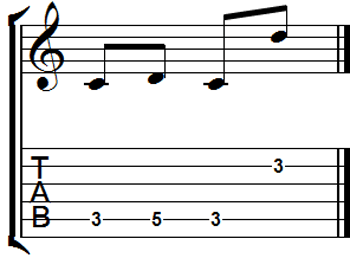Intervals Beyond One Octave
Going beyond small intervals to intervals larger than an octave is quite common. For example, playing a C note and then a D note, where
the D note is an octave higher than the D adjacent to the C note, is called a major ninth interval. A major eleventh interval is an octave
higher than a major fourth interval (4+7). A major thirteenth interval is an octave higher than the major sixth interval (6+7). Simply add
seven to the interval to get its octave interval. This number seven refers to major scale steps to get the next higher octave, and will be
discussed further in the Scale’s chapter. Figure 1 shows a C to D and a C to Octave D, major second and major ninth intervals.

Figure 1 -
C to D and a C to Octave D
Inverted Intervals
An Inverted interval is the interval distance between two notes starting from the second note to the first note. This is the
opposite way previously explained to determine intervals. For example, the interval distance from C to D is a major second. The
inverted interval distance becomes D to C, a minor seventh interval. Table 1 below shows inverted interval distances for the C
major scale (C, D, E, F, G, A, B).
|
Intervals (major scale)
|
Inverted Intervals
|
|
Major Second (C-D)
|
Minor Seventh (D-C)
|
|
Major Third (C-E)
|
Minor Sixth (E-C)
|
|
Perfect Fourth (C-F)
|
Perfect Fifth (F-C)
|
|
Perfect Fifth (C-G)
|
Perfect Fourth (G-C)
|
|
Major Sixth (C-A)
|
Minor Third (A-C)
|
|
Major Seventh (C-B)
|
Minor Second (B-C)
|
Table 1 - Inverted Intervals
Intervals Exercise
The exercise below shows all interval distances within one ocatave. Simply change the notes to see their interval distance. Study all intervals until they become fully memorized.
This interval name is called: Unison
Applied Intervals
Since intervals are the building blocks to everything used in songwriting, intervals need to be studied and practiced thoroughly. There are many
exercises to practice on each student’s instrument. A great exercise to practice is to randomly pick a starting note, and then practice playing every
interval distance until the starting note is reached. For example, table 1 demonstrated every interval within one octave starting from the C note. Try
practicing from the C# note, then starting from the D note, then shift the starting note to D#, etc. Then, practice the same exercise but determine the
inverted interval distances. When determining the interval distance between two notes played at the same time, always use the lower note as the first
note. Also, mastering intervals includes not just understanding and playing intervals, but also hearing what each interval sounds like. To become an even
better musician, recognize all interval distances by hearing them, not just seeing them on sheet music or on an instrument.
Intervals Can Create Anything
Combining intervals together are used to create everything composed in music! They can be used to build chords, scales, melodies, harmonies, voice leadings,
consonance, dissonance and much more. For example, the C chord and C arpeggio are both built from a major third interval and a perfect fifth interval. The major
scale is made of only major and perfect intervals (major second, major third, perfect fourth, perfect fifth, major sixth, and major seventh). A more
detailed explanation will be found in each of the following sections discussing how intervals relate to scales, chords, key signatures, and the circle of fifths.